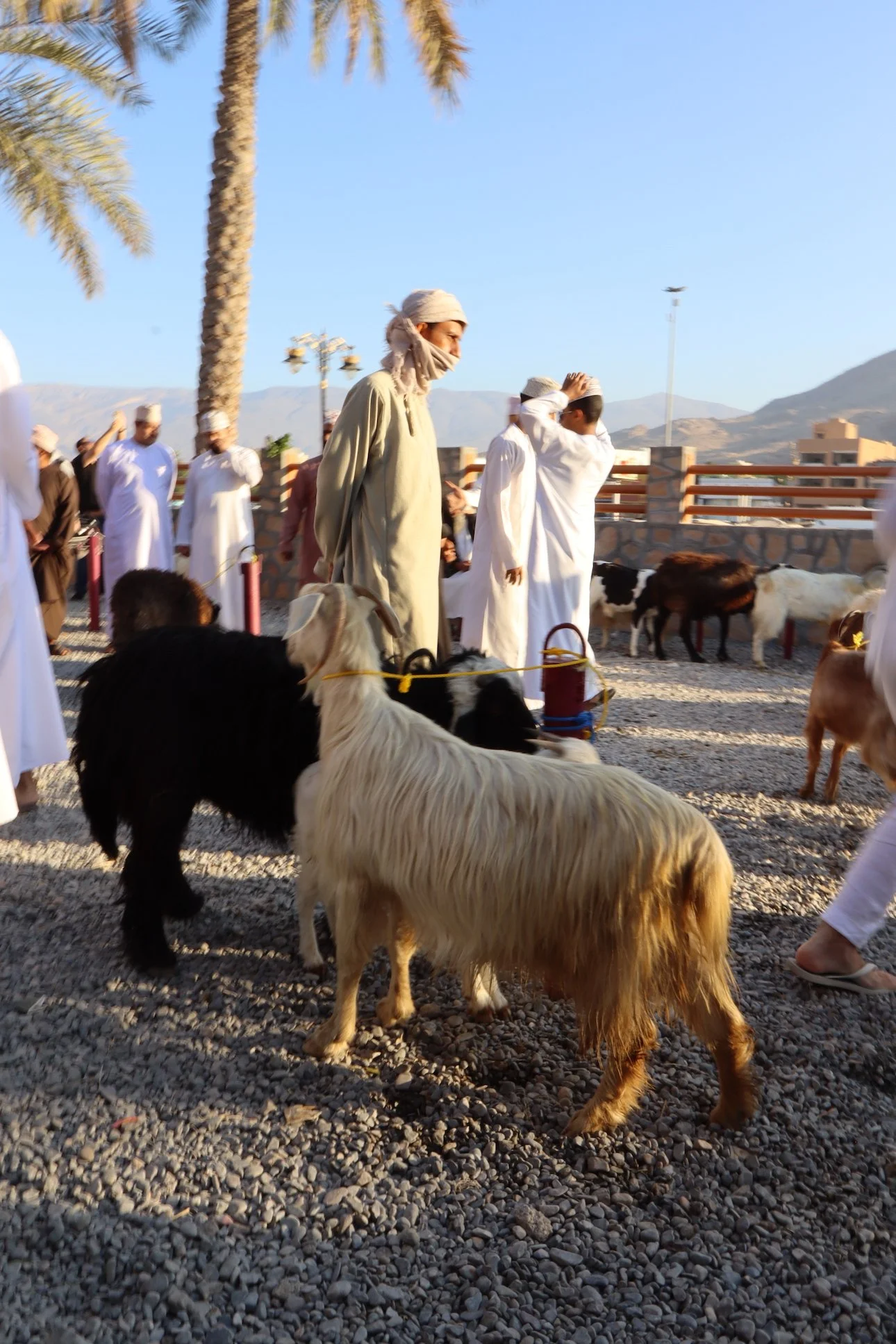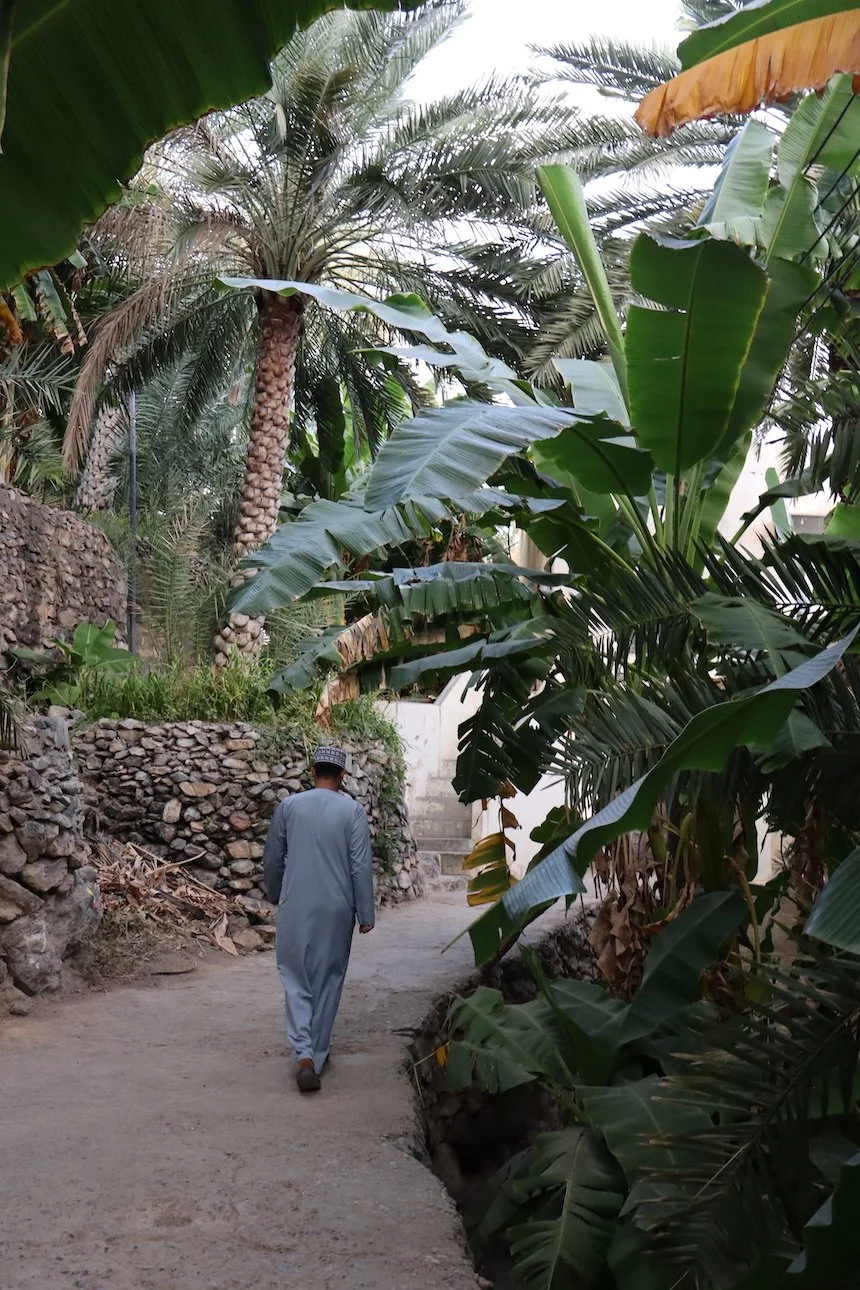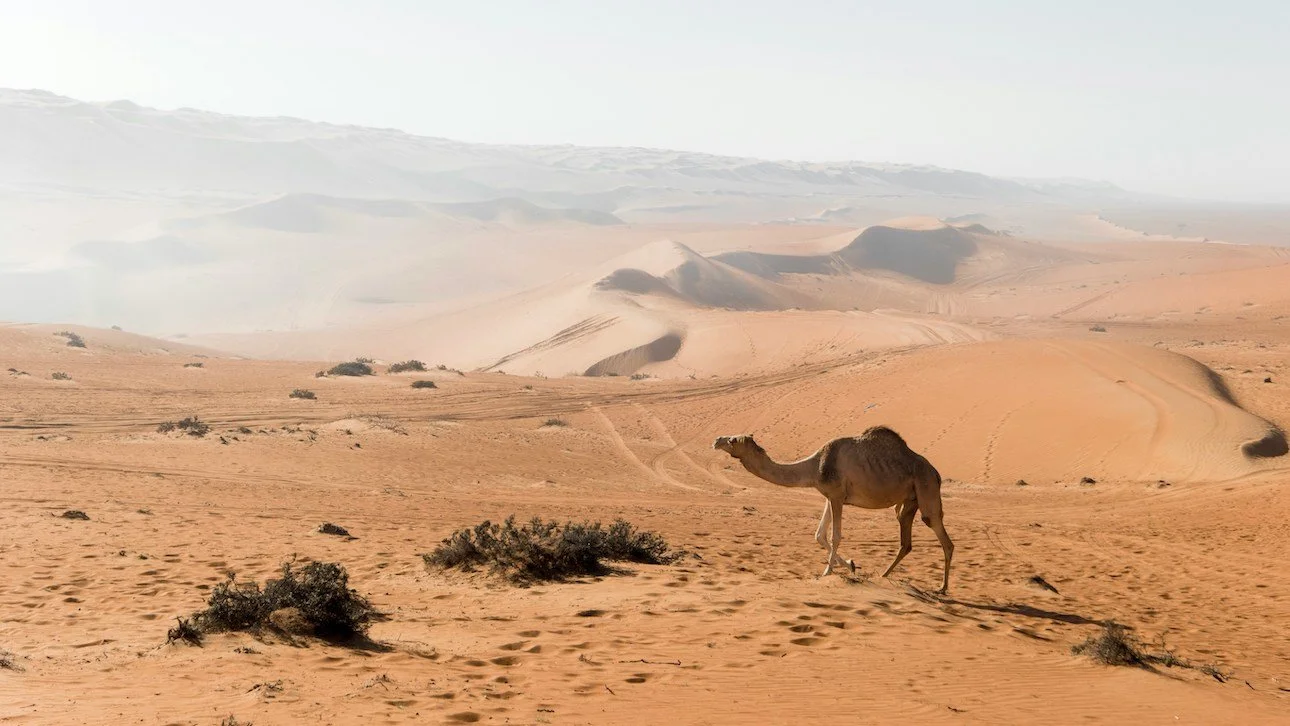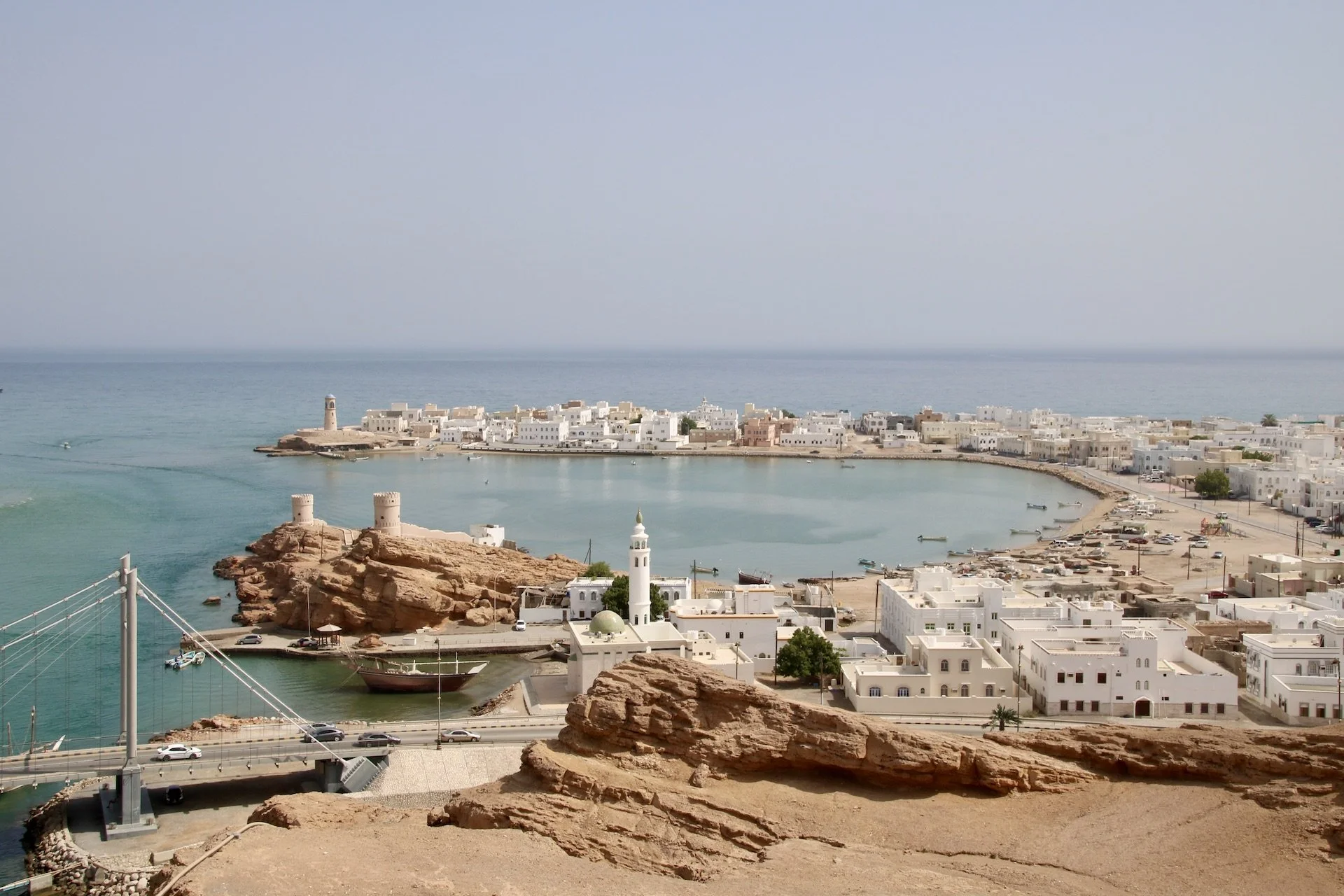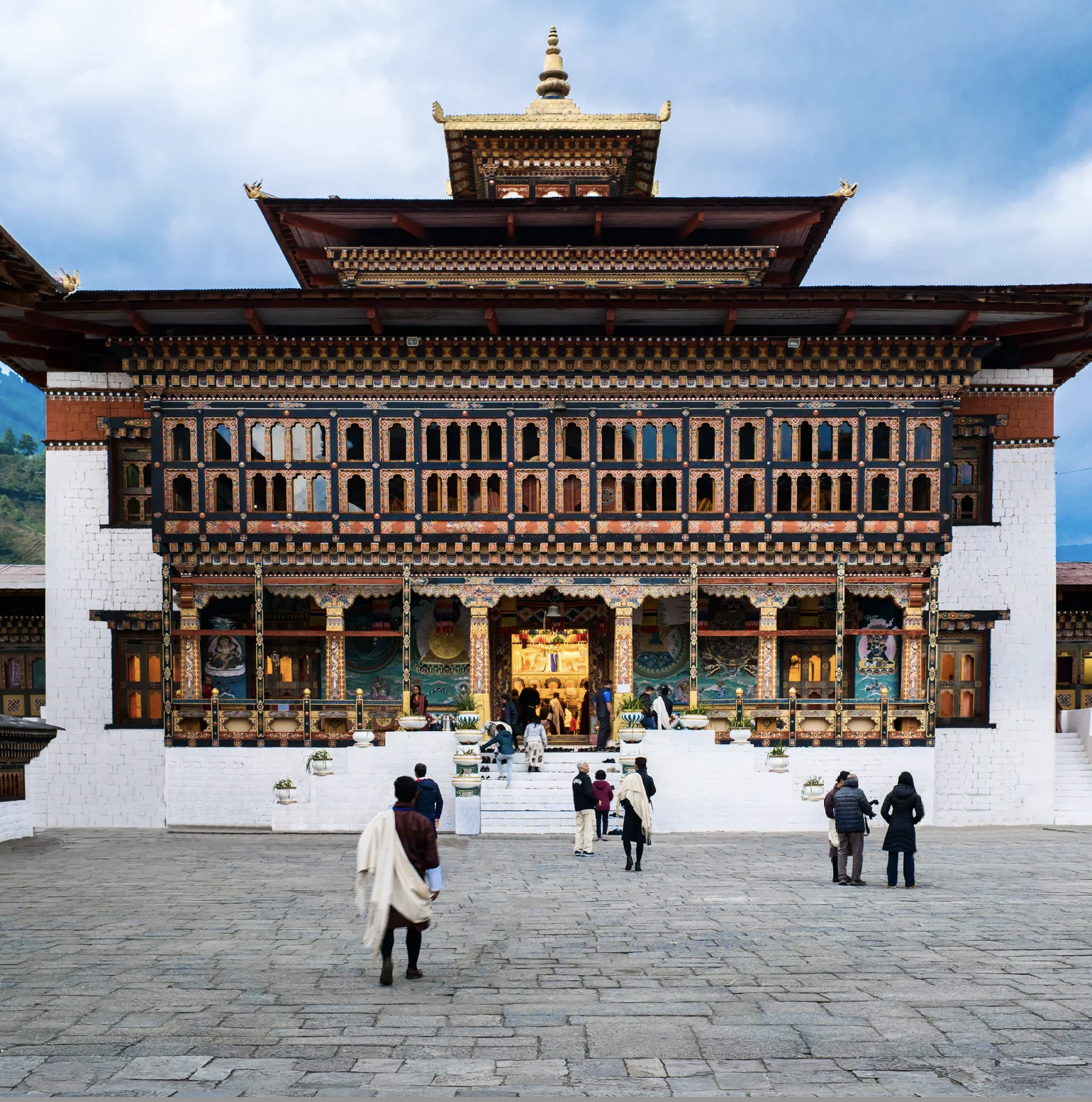
Journey to Oman & Bhutan
Luxury 18-day Multi-country Itinerary
Muscat, Nizwa, Jabal Akhdar, Sharqiya Sands, Sur, Dubai, Thimphu, Punakha & Paro 
Itinerary Outline
Day 1 -3 | Muscat | The Chedi Muscat (2 nights)
Day 3 - 5 | Nizwa | Heritage Inn (2 nights)
Day 5 - 7 | Suwgra | The Suwgra (2 nights)
Day 7 - 8 | Sharqiya Sands | Al Sarmadi Camp (1 night)
Day 8 - 9 | Sur | Ras Al Jinz Turtle Resort (1 night)
Day 9 - 11 | Muscat | The Chedi Muscat (2 nights)
Day 11 - 12 | Dubai | 25hours Hotel One Central (1 night)
Day 12 - 14 | Thimphu | Pemako Lodge (2 nights)
Day 14 - 16 | Punakha | Punakha River Lodge (2 nights)
Day 16 - 18 | Paro | COMO Uma Paro (2 nights)
Day 18 | Departure
Day 1 | Muscat
Arrival at Muscat & Airport Transfer
Arrival at Muscat International Airport. Continue through to immigration and customs. Meet your airport host at the main arrival hall and private transfer to your hotel.
Check-in to your hotel and settle into your accommodations. Recuperate from your journey with some spa treatments or time at leisure by the pool or on the private beach.
Leisure
Dinner at your hotel. Option to step out for a more local dinner experience.
The Chedi Muscat | Serai Sea View Room
Day 2 | Muscat
Sultan Qaboos Mosque
After breakfast meet your guide at the hotel lobby. Enjoy a private tour of the main sightseeing highlights of Muscat, starting with the Grand Sultan Qaboos Mosque – one of the most exquisite mosques in the Middle East. The mosque grounds cover 416,000 square metres and the actual the Mosque complex covers 40,000 square metres. It is constructed on a raised podium in keeping with the tradition of Omani mosques that were built elevated from street level. It can accommodate up to 20,000 worshippers and consists of a main prayer hall, ladies prayer hall, covered passageways, a meeting hall, and library that contains around 20,000 books. A major feature of the main prayer hall is the hand-made Persian carpet consisting of 1,700 million knots, weighing 21 tones and made in a single piece measuring 70 x 60 metres. From design stage it took 4 years to complete and 600 female weavers from province of Khurasan in Iran were involved.
Note: Ladies are required to cover their head with a scarf and wear long pants or a skirt to your ankles. Beachwear or sleeveless outfits are not permitted. Men are also required to wear long trousers – no shorts are allowed.
The National Museum
Visit the National Museum, the most prominent cultural edifice in the Sultanate of Oman, dedicated to highlighting Oman’s cultural heritage, since the emergence of human impact in Oman to the present day. It is the first museum in the Sultanate that includes a learning center, equipped according to the highest international standards, and is the first museum in the Middle East to employ the Braille system in the Arabic language.
Make a quick stop at Al Alam Palace, the official residence of His Majesty Sultan Haitham Bin Tariq the ruler of Oman. The palace is an architectural marvel for both its design and its location between the twin Portuguese forts Mirani and Jalali.
Mutrah Souq
Later, visit Mutrah Souq one of the most popular souks in the Middle East. Take a walk in its labyrinth of alleyways beckoning with a myriad of merchandise, from imported fabrics to oriental spices, perfumes and richly handcrafted artifacts.
The Chedi Muscat | Serai Sea View Room | Breakfast
Day 3 | Nizwa
Private Transfer to Nizwa
After breakfast, check out from your hotel. Today you will have full day visit of the historic town of Nizwa, Oman’s cultural capital. Along the way, stop by Jabrin castle built in 17th century. It is one of the finest of its kind. Its magnificent plasterwork, the carved doors and the painted wooden beams of the ceilings makes this castle amazingly different. Continue to Bahla, one of the oldest towns of Oman and in the 12th century was the capital of the tribe living in the region. The monumental fort is recently opened for public after a long restoration. Bahla is also famous for its pottery and you can visit a potter’s workshop.
Arrive at Nizwa in the late afternoon. Take a stroll through the old town and have dinner at your hotel.
Nizwa Heritage Inn | Standard Room | Breakfast, Dinner

Day 4 | Nizwa
Friday Market
Rise early to walk over tot he Friday cattle auction and market. The earlier the better, in order to get the full experience with the morning light coming in with a soft glow onto this marvelous scene dating back to the Middle Ages. We highly recommend stepping out at 7am before breakfast and returning to your hotel for breakfast at 9am.
Nizwa Fort
With your guide, explore the Nizwa Fort with its massive Circular Cannon Tower, one of the most impressive forts in Oman.
Al Hamra, Misfah & Jebel Shams
Drive to Al Hamra and Misfah to see one of the oldest villages of this region. The traditional mud houses dated back 400 years and are still occupied. The Falaj irrigation system used in this village is one of the oldest of this kind (UNESCO).
Continue on to Jabel Shams, one of the highest peaks of Hajr mountain range in Oman and is popularly known as the Great Canyon of Oman. Enjoy a gentle walk and stunning views of the region before returning to your hotel in Nizwa.
Nizwa Heritage Inn | Standard Room | Breakfast, Dinner
Day 5 | Jabal Akhdar
Barkat Al Mauz
Drive to visit the village of Barkat Al Mauz and enjoy a walk through the lush date plantations. Continue to Jabal Akhdar (2000 meters above sea level), the green jewel of the Al Hajjar Mountains. It is a truly unique spot in the Arabian Peninsula known for its jagged peaks and stunning valleys. Follow your guide as he takes you through the terrace gardens to view this intriguing location, the villages of Saiq, & Al Ain as they dot the landscape. The villages overlook spectacular scenery of dramatic peaks, gorges and wadis.
Al Suwgra Heritage Inn
Check-in to Al Suwgra Heritage Inn, a fascinating lodge built into the face of the mountain. Have dinner at the main guest house after settling into your room.
The Suwgra | Family Suite | Breakfast, Dinner
Day 6 | Jabal Akhdar
Jebel Akhdar
After a leisurely morning, explore the town of Jebel Akhdar. Continue from here to Ar Rus village known for its geological marker for one of the earth’s great mass extension. Continue exploring Jebel Akhdar and its fantastic scenery, hidden villages and historic sites before returning to your lodge where dinner will be served.
The Suwgra | Family Suite | Breakfast, Dinner
Day 7 | Sharqiya Sands
Oman Across Ages Museum
After breakfast, check out from the lodge and head to Manah. Arrive and visit the Oman Across Ages Museum. This museum offers visitors a comprehensive journey through the rich history and diverse heritage of the Sultanate of Oman. The museum's architecture is a blend of traditional Omani design elements and modern aesthetics. It reflects the country's commitment to preserving its heritage while embracing modernity. It boasts a vast collection of artifacts, artworks, and interactive displays that chronicle Oman's history from prehistoric times to the present day.
Sharqiya Sands
Continue to Sharqiya Sands in the Empty Quarter. The route to Wahiba Sands unveils a tapestry of natural beauty and cultural richness. As you leave Nizwa the road meanders through the tranquil expanse of the Al Wusta region, where the horizon stretches endlessly, dotted with occasional glimpses of Bedouin settlements and wandering camels.
The drive offers a unique transition from the Mountains to the undulating dunes of Wahiba Sands. Along the way, the landscape subtly shifts: sparse vegetation gives way to golden sands, and the air carries the distinct aroma of the desert. The journey is not just a passage through geography but a voyage through the essence of Oman's diverse terrains.
Upon reaching Wahiba Sands, also known as Sharqiya Sands, you're greeted by a mesmerizing sea of dunes that ripple across the landscape. This vast desert, spanning over 12,500 square kilometers, is home to the Bedouin tribes who have preserved their nomadic lifestyle amidst the sands. The area offers a plethora of experiences—from exhilarating dune bashing and camel treks to tranquil nights under star-studded skies. The ever-changing hues of the sand, from golden yellows to deep reds, create a dynamic canvas that captivates every traveler. After an awe-inspiring journey, you finally arrive at your desert camp, nestled quietly among the golden waves of the Wahiba Sands.
Enjoy dinner at the Al Sarmadi Camp after watching a dazzling sunset from the top of the dunes.
Al Sarmadi Camp | Royal Tent | Breakfast, Dinner
Day 8 | Sur
Wadi Bani Khalid
Check out from the camp and private transfer to Wadi Bani Khalid. This is considered one of the most beautiful wadis in Oman. The drive to Wadi Bani Khalid is through the Eastern Hajar Mountains, which offers a panoramic view of the landscape below. You will pass by many pretty villages embedded in the mountains. Here the road winds down to the wadi alongside a large, shallow pool fringed with vegetation and ends at a village. A short trek takes you to the deep blue pools of the wadi. Enjoy a swim and relax by the wadi.
Sur
Later, continue to Sur. The attractive coastal town of Sur has long been known for its tradition of dhow building, its shipyard continuing to produce these mighty vessels which have
formed such an important part of Omani culture and trade over the years, although these days there is less demand. Today it’s a relatively quiet town where one can walk through traditional markets surrounded by Omanis in their typical national dress, and it’s a good place to get a feel for local culture.
Visit the dhow open air museum which is dedicated to the shipbuilding lineage of the city of Sur in Oman. Built over 70 years ago, the wooden fishing vessel of Fateh Al Khair has strong historical significance to it. It was brought back to Yemen, restored, and grounded on dry land. The ship is said to be hand-built without any nails, and hand-woven ropes were used to shore up.
Family Lunch
Stop for lunch at a local home. In this home you will meet with Mariam, a retired teacher who took an early retirement and is now focused on NGO work for her community.
After lunch, drive to Ras Al Jin and check in at Ras Al Jinz Turtle Reserve. Enjoy an afternoon at leisure by the beach.
After dinner, assemble in the hotel lobby for a guided tour of turtle watching, where, after a journey of thousands of kilometres, mature females come ashore to lay their eggs.
Ras Al Jinz Turtle Resort | Luxury Eco Tent | Breakfast, Lunch, Dinner

Day 9 | Muscat
Wadi Shab
Wadi Shab is one of Oman’s most stunning natural wonders: a canyon oasis where turquoise pools, dramatic cliffs, and hidden waterfalls await adventurous travelers. This trek combines natural beauty with physical challenge, offering a rewarding escape into the wild landscapes of the Eastern Hajar Mountains.
Upon arrival at Wadi Shab, your journey begins with a short crossing by local fishermen's boat across a serene stretch of backwater. Once on the other side, the real adventure begins, a trek through the wadi, surrounded by towering cliffs and lush greenery fed by underground springs.
A moderate 15-minute hike (approx. 125 m elevation gain) leads to the first inviting pool. The path includes uneven and rocky terrain, so sturdy footwear is essential. Continuing for about 30 more minutes (approx. 230 m total elevation gain), the trail becomes more rugged and steep, offering rewarding views and access to the second pool perfect for a cooling dip. For those comfortable with water and more strenuous effort, the route continues another 15–30 minutes. This section involves swimming through deep water, navigating slippery rocks, and minor climbing to reach a hidden cave waterfall, a truly magical reward for the effort.
At the pools, enjoy time to swim, explore, or simply relax in the tranquil surroundings. A picnic lunch will be served in the wadi, allowing you to savor the beauty of this natural paradise before retracing your steps back to the base.
Travel to Muscat
Continue to Muscat. Arrive Muscat and check in to your hotel where you can relax and enjoy a delicious dinner.
The Chedi Muscat | Serai Sea View Room | Breakfast, Lunch
Day 10 | Muscat
Damaniyat Islands
This morning, private transfer to Al Mouj Marina. Embark on a speedboat and head to the beautiful Damaniyat Islands. It will take 45 minutes to reach the islands. Dive into the crystal- clear waters and explore the vibrant coral reefs teeming with marine life. Discover the underwater wonders of the islands, encountering colorful fish, turtles, and other fascinating marine creatures. Spend your day on the Island After the trip, relax and unwind at your accommodation, reminiscing about the day's adventures.
Lunch will be served on the beach with a private set up.
Later, return to Marina and transfer to your hotel for a final evening at leisure in Muscat.
The Chedi Muscat | Serai Sea View Room | Breakfast, Lunch
Day 11 | Dubai
Airport Transfer
Check out from the hotel and private transfer to Muscat International Airport. Arrive at the airport and check in at your airline counter to board your flight to Dubai.
Arrival at Dubai Airport. Head over to your airport hotel or choose to stay at a nearby airport if you prefer.
25Hours Dubai Hotel | Medium Bedouin Room | Breakfast
Day 12 | Thimphu
Airport Transfer & Flight to Paro
Private transfer to Dubai Airport in time for your flight to Paro.
Private Transfer to Thimphu
On arrival meet and greet at the Paro International airport and you will be transferred to Thimphu (1 hour drive). Stop at Tamchog Lhakhang for a private tour. Later, check-in to your hotel and take time to acclimate to the new altitude.
About Thimphu
Situated within the city centre and adorned with classical hand-drawn Buddhist murals, Taj Tashi successfully blends Dzong architecture and contemporary design, capturing the essence of modern-day Bhutanese culture. Within walking distance of some of the capital’s most renowned markets, restaurants, and sights, the hotel features 66 spacious rooms and suites with views of the surrounding mountains and townships.
Thimphu Farmers Market
Embark on a multi-sensory experience as you stroll past the vibrant stalls of the Thimphu Farmers Market. Drawing in most of Thimphu’s vivacious residents, the marketplace teems with a range of both local and imported goods and produce. The experience is far more than the items to be bought, but rather about socializing with the colorfully-dressed community, full of Bhutanese fare and flare. Many of the stalls sell fresh organically grown vegetables, ready to be transformed into delicious traditional and contemporary Bhutanese dishes, while the other areas promise a plethora of produce imported from India.
Pemako Lodge | Deluxe Room | Breakfast & Dinner
Day 13 | Thimphu
Buddha Dordenma
After breakfast, visit the Buddha Dordenma. This gigantic Shakyamuni Buddha statue is filled with over 100,000 smaller Buddha statues, and like the Buddha Dordenma itself, each are made of bronze and gilded in gold. Standing at an incredible height of 51.5 m (169 ft), Buddha Dordenma is recognized as one of the tallest Buddha statues in the world. The statue fulfills an ancient prophecy dating back to the 8th century CE, revealed by Terton Pema Lingpa, the Religious Treasure Discoverer of the time, and is said to bring peace and happiness to the entire world.
National memorial Chorten
This well-known landmark was built in 1974 in the memory of the third king, Jigme Dorji Wangchuck, who is popularly regarded as the Father of Modern Bhutan. This four-storey structure has become the most visible religious landmark in Bhutan. It serves as an important place of worship for Thimphu residents, as well as devotees from other parts of the country. Found within the temples' scared walls are carvings of mandalas, statues and religious teachings.
Have lunch at a local restaurant or at the lodge.
Royal Textile Academy and Royal Takin Preserve
Weaving is an integral part of Bhutanese culture and tradition. With the aim to conserve, restore, and document this living art, the Royal Textile Academy of Bhutan was set up by the queen mother, Her Majesty Ashi Sangay Choden Wangchuck as a non-government, non-profit organization. Inaugurated in 2001, the academy also educates young students in textiles, fabric design and museum studies. It serves as a centre for travelers, introducing the nation’s masterpieces to its visitors, while preserving Bhutan’s weaving traditions.
Bhutan's national animal is the takin. Legend has it, this large, shaggy, hoofed animal was created by the great Buddhist yogi, Drupa Kunley, otherwise known as ‘the Divine Madman’. This particular species of takin is found only in Bhutan and western Arunachal Pradesh. Located only 10 minutes from Thimphu city is the Royal Takin Preserve. Originally a zoo, until the fourth king decided to disband it since keeping animals in cages did not align with the country’s environmental and religious beliefs, the animals were released into the wild. However, the takin were too tame to survive, and wandered around the streets of Thimphu. This led to the making of the Royal Takin Preserve.
Rest of the day at leisure or stroll through the town.
Pemako Lodge | Deluxe Room | Breakfast & Dinner
Day 14 | Punakha
Private Transfer to Punakha
After breakfast, check-out and private transfer to Punakha (3 hour drive). Stop at Dochu La Pass and Chhimi Lhakhang.
Dochu La is an incredible Bhutanese mountain pass peaking at 3140 m (10301 ft) above sea level. Presenting exceptional views of the snow-capped eastern Himalaya on clear days, the pass links Thimphu and Punakha. Stop to see the Druk Wangyal Chortens, where 108 memorial stupas and chortens stand in honour of Bhutanese soldiers slain in the battle against Bodo militants from India. The Queen Mother, Ashi Dorji Wangmo Wangchuck, commissioned the shrine in 2003 after King Jigme Singye Wangchuck overcame the insurgents.
Located on a round hillock on the edge of the Punakha Valley, Chimi Lhakhang was built in 1499 by the 14th Drukpa hierarch, Ngawang Choegyel. After the site was blessed by ‘the Divine Madman’ the maverick saint, Drukpa Kunley. The temple draws local people to receive blessings from the lama, and it is famously known as the temple of fertility. The Bhutanese bring their new-borns to be named here. The Lhakhang is about a 30-minute walk through fields from the main road.
The Punakha River Lodge
On arrival check in to the lodge and relax over lunch. The Punakha River Lodge, nestled in the lush Punakha Valley along the Mo Chu river, offers a serene escape with luxury tents and suites amidst verdant paddy fields and forested hills. Built in traditional Bhutanese style, the lodge seamlessly blends with its surroundings. Adventure seekers can enjoy activities like rafting, kayaking, and hiking in the picturesque landscape. For relaxation, the spa nestled in an orange orchard offers rejuvenating treatments and yoga sessions. Indulge in traditional Bhutanese hot stone baths for ultimate relaxation. Guests can dine on a fusion of Indian, Tibetan, and Chinese cuisine in scenic spots like the suspension bridge adorned with prayer flags. Punakha River Lodge promises an unforgettable experience for outdoor enthusiasts and those seeking tranquillity amidst Bhutan's natural beauty.
Punakha Dzong
Visit the Punakha Dzong. Constructed in 1637, this was the second dzong in the country, the towering white walls form a lovely contrast to the surrounding greens and blues. The very first National Assembly was held here in 1953, as well as the royal wedding between King Jigme Khesar Namgyel Wangchuck and Queen Jetsun Pema in 2011. It is also the winter residence of the central monastic body, and holds a very important relic over which many wars were fought with the Tibetans. All of Bhutan's kings are crowned here before they can take their throne in Thimphu. Punakha Dzong’s magnificence is especially striking in the spring when the lilac-coloured jacaranda trees are in full bloom.
Punakha Suspension Bridge
Stretching across the Pho Chhu, the Punakha suspension bridge is 180 m (590 ft) in length, making it one of the longest suspension bridges in the country. It connects Punakha Dzong to the surrounding villages, and offers a great view of the glistening stream below.
Punakha River Lodge | Tented Suite | Full-Board
Day 15 | Punakha
Khamsum Yuelley Namgyel Chorten
After breakfast, visit Khamsum Yuelley Namgyel Chorten.This three-storey lhakhang is a recent addition to Bhutan's string of architecturally splendid buildings. Built by Her Majesty the Queen Ashi Tshering Yangdon, it houses representations of the tantric form of Buddhist deities that subjugate enemies and ward off harmful influences on the people of Bhutan. Built for the protection of the country and the present king, Khamsum Yuelley Namgyal Chorten also offers impressive views of the valley below.
Pho Chu River Rafting (for Penny)
The Pho Chu, which translates to ‘male river’, is fed by glaciers in the Lunana region. A favorite amongst thrill-seeking travelers, its 16 km (9.9 mi) course is loaded with 15 different rapids, ranging from class 2 to 4, making it the perfect spot to embark on a rafting adventure. At the confluence between Pho Chu and Mo Chu lies the Punakha Dzong, and thereafter the main river is known as Punatsang Chu. This merger is also where your rafting experience ends. On your rafting journey you will witness breath-taking views of alpine scenery, secluded stretches of serene sparkling water.
Return to the lodge for lunch.
Sangchhen Dorji Lhendrup Nunnery
Afternoon visit Sangchhen Dorji Lhendrup Nunnery where you will experience the blessing ceremony. Perched on a ridge amongst the pine trees gleams the magnificent structure of the Sangchhen Dorji Lhuendrup Lhakhang. This temple houses a 4.2 m (14 ft) bronze statue of Avalokiteshvara, made by local Bhutanese artisans. Other statutes include those of The Buddha, Guru Rinpoche, Zhabdrung Ngawang Namgyel, Tsela Namsum, and the 21 Taras. The temple complex also houses a permanent school of higher learning and a meditation centre for nuns where, apart from religious training, provides vocational training such as tailoring, embroidery, statue making and thangka painting.
Blessing Ceremony
Become immersed in Bhutanese culture, with a Tshewang (blessing) ceremony for personal empowerment, wish fulfillment, and a healthy life. The prayer will be approximately 30-minutes, during which you can make an offering by lighting butter lamps.
Bali Village Walk
Towards the evening, go for a Bali village walk, where you can experience the Ara (local rice wine) brewing. You will have the option to walk (over a 118 m (387 ft) suspension bridge over the Mo Chu) or cycle (on the main road) to the Bali village. The village consists of over 30 households. Villagers there depend on agriculture and grow chillies, beans, slipper gourd, cucumber and eggplant to supplement their income. The agricultural produce is taken to Khuruthang town for sale during the weekends.
Ara Making in Bali Village
At Bali you will visit Aum Tshewang Pem's home where she will demonstrate how Ara (local rice wine) is made. Ara is a traditional alcoholic beverage made from rice, millet or wheat, ara can be fermented or distilled. It is enjoyed at all social functions in Bhutanese life.
Punakha River Lodge | Tented Suite | Full-Board
Day 16 | Paro
Private Transfer to Paro
This morning drive towards Paro (3 to 4 hours' drive). Paro is a historic town, situated at 2250 m (7382 ft,) with many sacred sites and historical buildings scattered through the area. It is home to many of Bhutan's oldest temples and monasteries, the National Museum and the country's only international airport. Mt Jhomolhari (7326 m /24035 ft) reigns in its white glory at the northern end of the valley. Its roaring glacial water plunges through deep gorges to form the Pa Chu (Paro River). Paro is one of the most fertile valleys in the Kingdom producing a bulk of the locally famous red rice from its terraced fields.
On arrival check in and relax over lunch at COMO Uma Paro. Combining Bhutanese tradition with contemporary style, COMO Uma Paro is a cherished resort elegantly positioned on the slopes of the Paro Valley. Nine private villas and 20 luxury rooms flawlessly incorporate colorful local craftsmanship into clean-lined modern design, boasting exceptional views of the forest, mountains, and valley floor. Built from handcrafted stone, wood, and tiles, the rooms feature wooden furniture decorated in vivid floral designs, and hand-stitched bed linen. The resort’s award-winning Bukhari restaurant offers fine dining menus that incorporates both local and international dishes. Additional facilities include an indoor pool with an open-air sundeck, a fully equipped gym, and a yoga studio.
Ta Dzong (National Museum)
Afternoon visit to Ta Dzong. Ta Dzong was a watch tower built to defend Rinpung Dzong during the inter-valley wars of the 17th century. Since 1967, the Ta Dzong has been serving as the country’s National Museum. The museum boasts a fascinating collection of art, relics, religious thangka paintings, natural history, and Bhutan's exquisite postage stamps. The building's circular shape comes from its defensive origin.
Farmhouse Experience
The beauty of Paro Valley is embellished by clusters of old-fashioned yet colorful, decorative and traditionally built farmhouses. A visit to a local farm offers a glimpse into the everyday life of the farmer.
Enjoy the rest of the day at leisure.
COMO Uma Paro | One Bedroom Villa | Breakfast & Dinner
Day 17 | Paro
Tiger’s Nest
Early this morning, take a short drive to Ramthankha, and start your hike to the Taktsang monastery (Tiger’s Nest). Built on a sheer cliff face at a height of 2950 m (9678 ft), the four-hour trek to Taktsang Monastery offers spectacular views. The trail climbs through a beautiful pine forest, many of the trees festooned with Spanish moss and an occasional grove of fluttering prayer flags. Legend has it that Guru Rinpoche, founder of Buddhism in Bhutan, flew from eastern Bhutan on a tigress, bringing Buddhist teachings and meditation to the cliff. This is one of the most venerated and sacred of all Buddhist sights around the world.
Altitude gain: 900 m (2952 ft) | Hiking time: 5 hours
Return to the lodge for lunch.
Visit Phuba Mandala Display Center
In the afternoon if energy permits visit a Phuba Mandala Display Centre. A mandala is a sacred geometric symbol, typically within a circular frame. They can be painted on cloth or created with colored sand or rice on the ground. In Buddhist tradition they are used to focus the mind during meditations. It can represent a spiritual journey to the inner core through the outer layers. Witness skilled monks with many years of training create sand mandalas and learn about their significance.
Towards the evening, stroll thought the Paro town and look for souvenirs to take back home.
COMO Uma Paro | One Bedroom Villa | Breakfast & Dinner
Day 18 | Departure
Airport Transfer & Flight to Dubai
Today you will be transferred to Paro international airport for your onward flight to Dubai.

Pricing & inclusions
Starting at $18,000 per person
Price per person based on two people in double occupancy.
All Accommodation: As listed in the itinerary at the bottom of each day with the respective room categories.
Private Transport: A dedicated English speaking driver at disposal throughout the trip on both Oman and Bhutan, in 4x4 AC vehicles.
Flights: Regional flights connecting the destinations as listed in the itinerary.
Tours & Activities: Your driver is also a guide in Oman and will accompany you throughout the trip. All activities and tours listed in the itinerary are included, as well as their associated fees and entrances. In Bhutan the tour will be provided as per the itinerary with an English-speaking Bhutanese guide. All entrance and monuments fees are included.
Meals: All breakfasts, some meals, as indicated in the itinerary at the bottom of each day.
Other: City taxes associated with your accommodations. Recommendations for independent exploration and insider tips. Restaurant reservations and coordination.
Exclusions
International Flights
Travel insurance (required for this trip)
Tips
Extra tours and guides otherwise not listed







